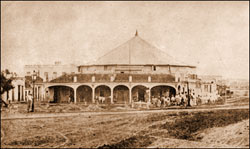8.2.3 The Guaracha.

Cuban popular music embodies the defining characteristics of our identity. One of them is, without a doubt, our ability to laugh and make others laugh. Humorous resonances can be found in many musical genres born in Cuba, but the one that best reflects this is the guaracha.
The first known guarachas were part of comic theater, and based on the costumbrist themes that characterize it, the verses of these songs often had humorous intentions. Guarachas possessed a musical form indebted to the Hispanic stage tonadilla, although permeated by the Antillean rumba. From their beginnings, they were a spokesperson for the festive and satirical spirit of the Cuban people.
This genre was linked to the realization of the Cuban Creoles’ independence ideals, as the people used it to criticize, in a mocking and mischievous tone (sometimes with a sharp double entendre), colonial rulers and situations arising from the peninsular oppressive regime. On January 13, 1869, at the Villanueva Theater in Havana, a guaracha was sung that contained elements of a veiled attack: Ya caído (It has already fallen), alluding to the liberation war taking place in eastern lands.
Guarachas were accompanied by guitars, along with rattles like the güiro and maracas. Later, the tres was added. The voices of the guaracheros echoed the refrain, with the chorus providing thematic support for the verses sung by a soloist. A critique of customs, Cuban grace found in guarachas the ideal setting for its humorous inspiration.
When the guaracha broke away from comic theater and entered dance halls, it retained its intention of invoking laughter. This occurred in the 20th century and had very positive results for the musical genre, because, thanks to the interest of composers from various types of orchestral groups, the guaracha initially began to be played and sung alongside other genres, and then the idea of creating compositions where it blended harmoniously with them arose. Thus, the guaracha son and the guaracha conga emerged.
Among the most important Cuban composers who dedicated themselves to composing guarachas, we can mention Ñico Saquito, but it is common for popular composers, since the 19th century, to compose this genre and others as well.
Since then, the guaracha has consistently appeared throughout the creative process of Cuban composers, always reflecting aspects of everyday life and situations that had a profound impact at the time. In the final decades of the 20th century, the greatest exponent of the guaracha is Pedro Luis Ferrer, a troubadour whose compositions are intensely felt. He has given abundant examples of his Cuban identity, making a point of drawing on many forms of our music. He has successfully created guarachas that, like all classic pieces of their genre, have become part of the collective heritage.








